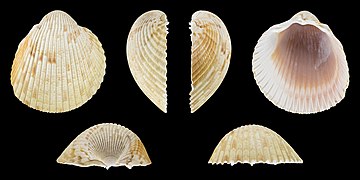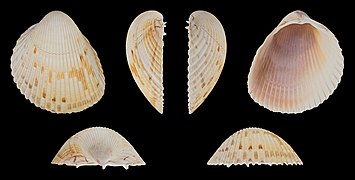Dinocardium
| Dinocardium | |
|---|---|

| |
| Shell of Dinocardium robustum from Florida at the Museo Civico di Storia Naturale di Milano | |
| Scientific classification | |
| Domain: | Eukaryota |
| Kingdom: | Animalia |
| Phylum: | Mollusca |
| Class: | Bivalvia |
| Order: | Cardiida |
| Family: | Cardiidae |
| Genus: | Dinocardium Dall, 1900 |
| Species: | D. robustum
|
| Binomial name | |
| Dinocardium robustum (Lightfoot, 1786)
| |
| Synonyms | |
| |
Dinocardium is a genus of large saltwater clams or cockles, marine bivalve molluscs in the family Cardiidae, the cockles. There is only one species in the genus, Dinocardium robustum, or the Atlantic giant cockle.
Description
[edit]Dinocardium robustum has a shell that reaches a length of 100–125 mm. This large and sturdy shell is obliquely ovate, with crenulate margins and about 32–36 rounded radial ribs present on both the inside and the outside. The valves are symmetrical with one another (equivalve). The basic color of the surface usually is creamy white, mottled with reddish-brown markings, while the interior is pinkish. This cockle burrows into the substrate by means of its strong foot, and like most bivalves feeds by filtering the water for plankton.
Distribution
[edit]This species can be found along the western Atlantic coast of North America, in the Gulf of Mexico and in the Caribbean Sea.
References
[edit]External links
[edit]- Photos of Dinocardium on Sealife Collection




